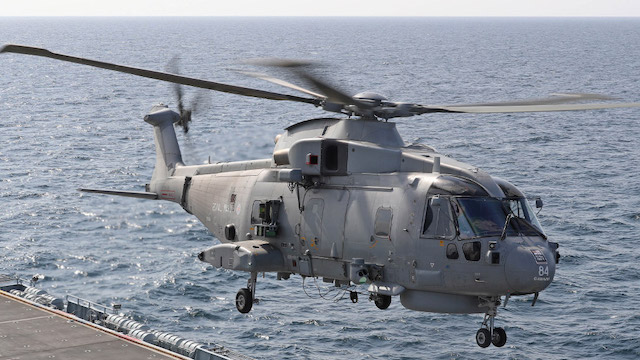AW101
Summary
| Category | Military Helicopters |
| Origin country | 🇬🇧 United Kingdom • 🇮🇹 Italy |
| Manufacturer | AgustaWestland |
| First flight | 19 October 1964 |
| Year introduced | 1999 |
| Number produced | 137 units |
| Average unit price | $70 million |
Description
In 1977, the UK Ministry of Defence sought an anti-submarine warfare (ASW) helicopter to replace the Royal Navy's Westland Sea Kings. Westland Helicopters proposed the WG.34, a three-engined helicopter similar in size but with greater range and autonomy. Concurrently, the Italian Navy was also considering a Sea King replacement built by Agusta, leading Westland and Agusta to collaborate on development. They formed EH Industries Limited (EHI) to develop and market the new helicopter. The UK government confirmed its participation in June 1981 with an initial budget for nine pre-production models. A major funding agreement between the British and Italian governments was signed in 1984. Agusta displayed a mock-up of a utility version at the 1985 Paris Air Show. The first prototype flew on 9 October 1987. Several pre-production aircraft were assembled in the late 1980s and early 1990s, with the first powered by General Electric CT7-2A engines. Flight tests were suspended for six months after a crash in 1993. On 6 June 1993, the first EH101 flew with the Rolls-Royce Turbomeca RTM322 turboshaft engine. Nine prototypes were built for military and civil applications. In February 1995, Britain ordered 22 EH101s, followed by Italy with 16 in October 1995. RAF deliveries began in 1997, and RN deliveries the following year. Following the merger of Westland and Agusta to form AgustaWestland in 2000, the EH101 was re-branded as the AW101 in 2007.
The AW101 follows a conventional design layout, but integrates advanced technologies in areas such as rotor blade design, avionics systems, and the extensive use of composite materials. Its modular fuselage structure incorporates an aluminum–lithium alloy, selected for its lightweight and damage-resistant properties. Designed to operate in extreme weather conditions, the AW101 is equipped with a de-icing system and is rated for temperatures ranging from −45 to +50 °C. The aircraft’s control systems enable stable hovering in crosswinds of up to 74 km/h (40 knots). An active vibration control system, known as the active control of structural response system, reduces airframe vibration by up to 80%. The cockpit is fitted with armored seats for the crew, capable of withstanding impact velocities of over 10 m/s. Dual flight controls are standard, although the AW101 can be flown by a single pilot. Pilot instrument displays include six full-color high-definition screens and an optional mission display, with available installations of a digital map or forward-looking infrared (FLIR) display.
Most variants of the AW101 are equipped with self-defence systems, such as chaff and flare dispensers, directed infrared countermeasures (infrared jammers), ESM (electronic support measures in the form of RF heads), and a laser detection and warning system. British Merlins have been outfitted with protective armour against small-arms fire. A side-mounted forward looking infrared (FLIR) imaging sensor has been fitted to some variants. Two hardpoints are present in the underside of the airframe on which the HM1 model can carry four Sting Ray torpedoes or Mk 11 Mod 3 depth charges. Some customers have chosen to deploy the Marte anti-ship missile on the AW101. The Mk1, Mk3 and Mk3A variants can mount general purpose machine guns in up to five locations in the main cabin, aimed out of both door and window apertures.
The AW101 has been deployed to active combat theatres, such as in support of coalition forces during the Iraq War and the war in Afghanistan, serving with the Royal Air Force as the Merlin HC3, often utilized for troop transport duties. The Royal Navy's Merlin HM1 has seen action in the Caribbean, performing counter-narcotics and hurricane support duties, as well as maritime security duties in the Persian Gulf. Italian AW101s have seen service overseas, including deployment to Afghanistan where they have been flown in both transport and utility roles. The AW101 has also been used in search and rescue, VIP transport, and support for Antarctic expeditions.
Main Variants:
-
Model 110: An Italian Navy ASW/ASuW variant, equipped with T-700-GE-T6A1 engines, Eliradar APS-784 radar, Honeywell HELRAS dipping sonar, and armed with torpedoes or Marte anti-ship missiles.
-
Model 111: A Royal Navy ASW/ASuW variant, designated Merlin HM1, powered by RTM322 engines and fitted with Blue Kestrel radar, Thomson Marconi FLASH dipping sonar, and Orange Reaper ESM.
-
Model 112: An Italian Navy early warning variant with the same airframe as the Model 110 but featuring Eliradar HEW-784 radar in a large under-fuselage radome.
-
Model 411: A Royal Air Force transport variant, designated Merlin HC3, used for troop transport duties and the transport of bulky objects, either internally or underslung.
-
Model 511: A Canadian Armed Forces search and rescue variant, designated CH-149 Cormorant, equipped for operations in the North Atlantic.
Technical specifications
| Version: A.101G | |
|---|---|
| Crew | 2 members |
| Maximum speed | 241 km/h (150 mph) |
| Height | 6.6 m (21.5 ft) |
| Length | 20.4 m (66.9 ft) |
| Service ceiling | 2,600 m (8,530 ft) |
| Empty weight | 6,850 kg (15,102 lbs) |
| Max. takeoff weight | 12,900 kg (28,440 lbs) |
| Climb rate | 14.5 m/s (47.6 ft/s) |
| Powerplant | 3 x turboprops Rolls-Royce Gnome H1400 delivering 1044 kW each |
Current operating countries
| Country | Units | ||
|---|---|---|---|

|
United Kingdom | 51 | |

|
Italy | 30 | |

|
Norway | 15 (+1) | |

|
Denmark | 14 | |

|
Canada | 13 (+3) | |

|
Japan | 12 (+1) | |

|
Portugal | 12 | |

|
Algeria | 5 | |

|
Poland | 1 (+29) | |
All operators

